There’s a fine, fine line between effective exfoliation and too much exfoliation. (Finer than the fine lines that we’re trying to minimize here.) Finding that line can be a challenge, since it’s so fine and its location varies so much from person to person.
Some people do best with little to no exfoliation. Others like to use multiple acids, use them often, and see a lot of success. My friends Tracy from Fanserviced-B and Kerry from Skin and Tonics come to mind. Yet others can’t handle that but want a bit more than the minimum. (Me.) If you’re looking for a milder alternative to common chemical exfoliants, polyhydroxy acids (PHAs) might be right up your alley. Let’s check out my personal introduction to these so-called next-gen AHAs: Swanicoco PHA 10% Coco Peeling Cream!
The product featured in this post was provided for my consideration by a Fifty Shades of Snail sponsor.
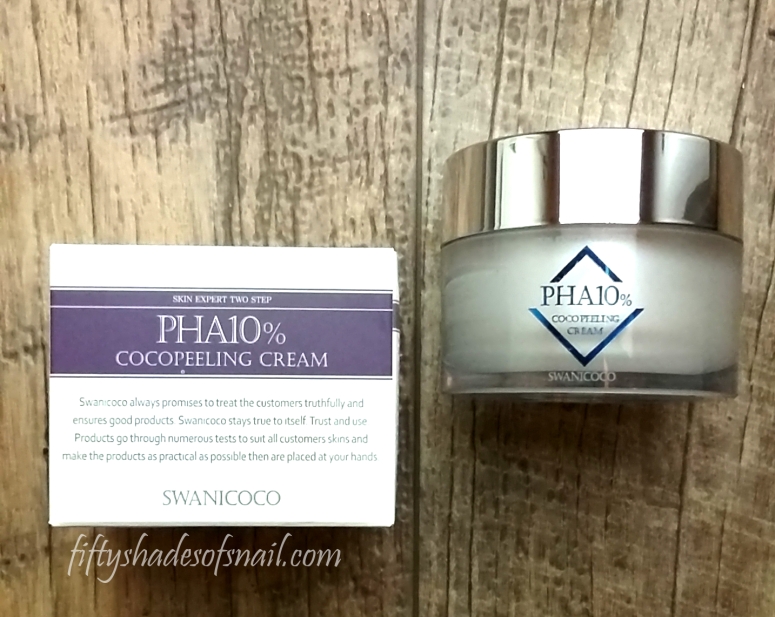
PHA 101; PHAs vs AHAs
PHAs have been touted as “the next generation of alpha hydroxy acids.” The effects of properly formulated PHA products are similar to those of comparable AHAs: improved skin texture, tone, clarity, and firmness, and reduction in hyperpigmentation and other visible signs of UV damage.
The key difference between PHAs and AHAs lies in the molecule size. PHA molecules are substantially larger than AHA molecules, which means that they penetrate more slowly and less deeply than AHAs. (Don’t even think about making a dirty joke here.) The slower and more shallow penetrationehehehe reduces the potential for irritation, but it also means that PHAs are more effective at surface issues like fine lines and hyperpigmentation, while AHAs are slightly better for deeper issues like firmness, according to a 12-week study referenced in a 2004 paper. PHAs are also more humectant than AHAs, making them possibly more beneficial for dry and/or dehydrated skin.
The 2004 paper I referenced above also claims PHAs are “compatible with sensitive skin conditions such as rosacea and atopic dermatitis,” but I am not giving medical advice, so I will leave that between you and your dermatologist.
What I do find especially promising are claims from multiple sources that PHAs are particularly compatible with skincare routines containing retinoids like my beloved Curology tretinoin. I’ve cut way back on my AHA usage to prevent thinning out my skin too much, so I was excited to try a product that might let me get a little more regular exfoliation into my routine without going over the top.
Swanicoco PHA 10% Coco Peeling Cream Review
The PHA 10% Coco Peeling Cream came to me in a big box of products I agreed to accept from Swanicoco last fall. I’ve had this product in my routine for about two and a half months now.
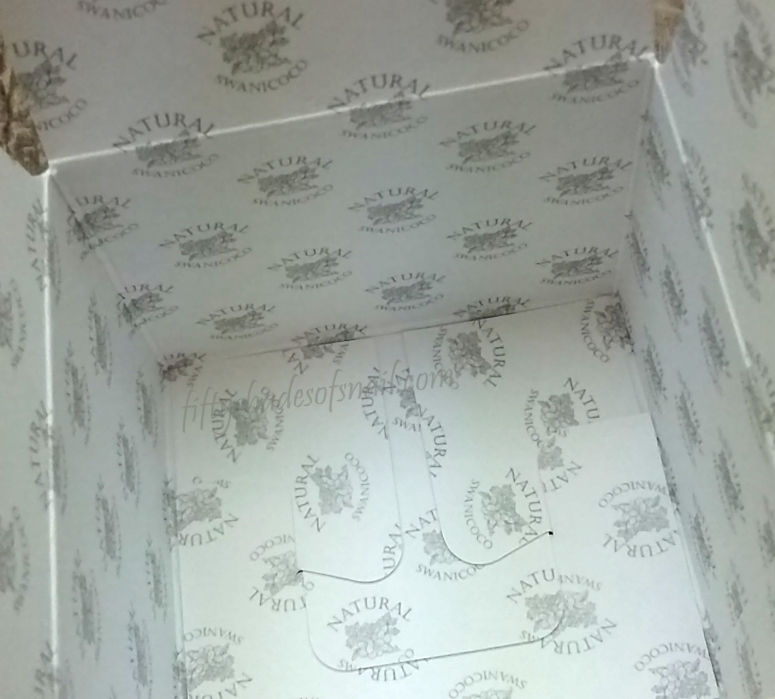
Purpose: Swanicoco PHA 10% Coco Peeling Cream is a chemical exfoliant that claims to gently smooth skin texture and brighten skin tone.
Best suited for: Normal, dry, and/or sensitive skin types.
Do not use if: You are sensitive to fatty alcohols, vitamin E, stearic acid, or anything else in the ingredients list.
When and how to use: At the last or second-to-last step of your evening skincare routine, apply a thin layer of product. Gently massage into skin and let dry fully. Do not rinse off. (Need help putting your products in order? Read this post!) And make sure to use sunscreen during the day to prevent additional UV damage from the potential photosensitizing effects of the exfoliation.
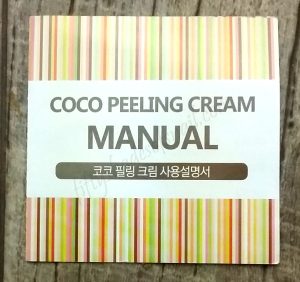
Swanicoco PHA 10% Coco Peeling Cream ingredients: Vaccinium angustifolium (blueberry) fruit extract, gluconolactone, glycerin, caprylic/capric triglyceride, niacinamide, 1,2-hexanediol, neopentyl glycol diheptanoate, glyceryl stearate, PEG-100 stearate, cetyl alcohol, potassium hydroxide, lactobionic acid, hydroxypropyl bispalmitamide MEA, stearic acid, behenyl alcohol, sorbitan sesquioleate, tocopherol, hamamelis virginiana (witch hazel) water, centella asiatica extract, camellia sinensis leaf extract, juglans regia (walnut) seed extract, allantoin, hydrolyzed hyaluronic acid, polyacrylate-13, polyisobutene, polysorbate 20, polyacrylamide, C13-14 isoparaffin, laureth-7, helianthus annuus (sunflower) seed oil, macadamia integrifolia seed oil, argania spinosa kernel oil, citrus aurantium bergamia (bergamot) fruit oil, pelargonium graveolens oil, rosa damascena flower oil
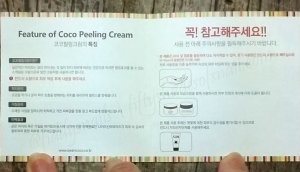
Notable ingredients: The key exfoliator in the Coco Peeling Cream is gluconolactone, but it also contains lactobionic acid, another PHA that one study compared to glycolic acid and found gentler and safer for skin overall. The 10% PHA concentration is within the range I’ve seen used in various studies of PHA effectiveness as a skincare ingredient, so that’s good.
I haven’t found any specific and credible sources for the effective pH range of PHAs, but since they are so similar to AHAs, I’m guessing that the pH range should be fairly close. The pH of this cream, according to my strips, is just a titch over 4, so it should be able to work without being too extra for exfoliation-sensitive skin.
Besides the exfoliants, which also have antioxidant properties, this cream contains the usual mix of antioxidant/anti-inflammatory extracts. I appreciate that its base is an extract rather than plain water. Even if the extract is fairly weak, it’s still possibly a little more beneficial than water alone.
Vitamin E is known to be quite comedogenic for some people, so if you have a sensitivity to it, definitely patch test first. I doubt there’s much in the cream, but better safe than broken out and angry, right?
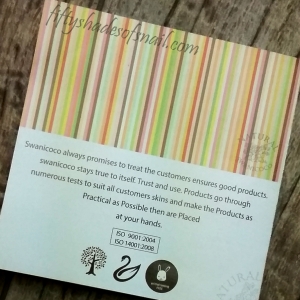
Performance
Swanicoco PHA 10% Coco Peeling Cream is a soft, thin cream with a very faint fresh/citrusy(?) scent and a hint of the stretchy-chewy texture that I associate with snail creams.
The feel of the cream when applied is interesting. It starts out soft but stiffens up slightly as it’s spread out, leading to a little bit of drag on my skin if I’m applying a very small amount and requiring me to use more cream than I need to if I want to avoid the drag. I don’t worry that much about rubbing and tugging causing premature wrinkles, but I do prefer products that apply more smoothly.
I also prefer products that dry down well. The Coco Peeling Cream dries to a shiny finish, but without any oily or heavy feel. It can be sticky, however. Kevin, my friendly and handsome Swanicoco contact who has great skin, advises massaging the product in thoroughly to reduce the sticky finish. This does work but is more labor-intensive than my lazy self enjoys. Instead, I generally let my Coco Peeling layer dry and absorb for about 30 minutes, then add a very thin layer of a super lightweight moisturizer on top. (The best one in my stash for this is Mizon Snail Recovery Gel Cream.) The final layer kills off any stickiness completely.
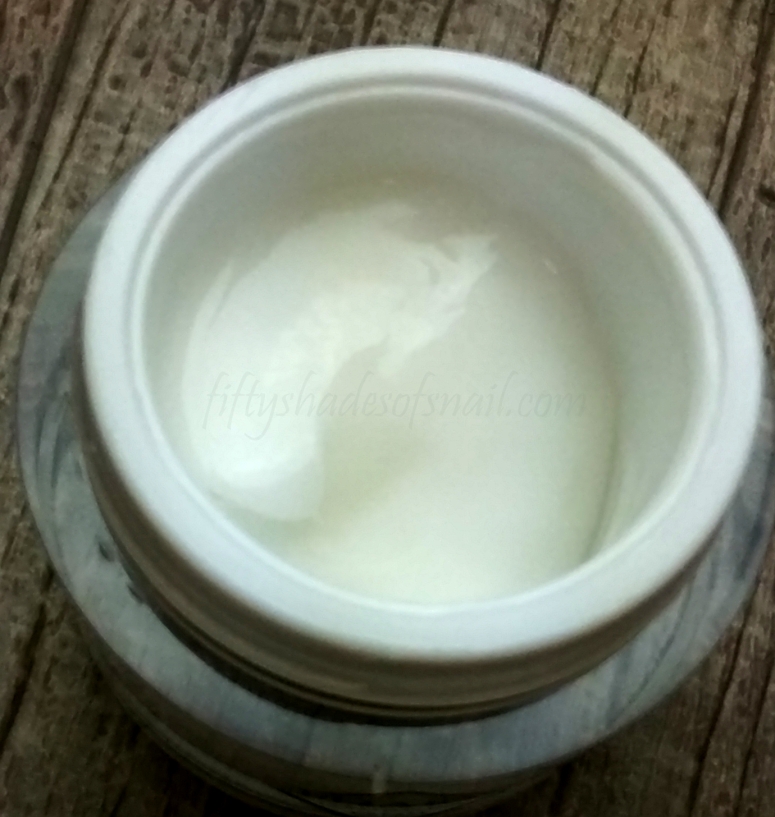
The other reason I prefer to add a final moisturizing layer after the PHA cream is because I don’t always find the Coco Peeling Cream moisturizing enough for my (mostly normal but sometimes skews dry) skin on its own. I think this could work as a standalone moisturizing step for fully normal or oilier skin types, but my skin often felt as if it needed something more after a couple of hours. Kevin did point out that emulsion can be used under the cream, but I’d rather save the moisturizers for after an active.
Kevin’s recommendation for pre-PHA steps were a first essence, toner, and emulsion. He suggested that too many layers under the Coco Peeling Cream could interfere with penetration, which makes sense. My routines are generally more elaborate, but my sheet masks after serums tend to leave the surface of my skin feeling quite bare, and I had no issues applying this product as a post-sheet mask step.
But does it exfoliate?
Because I can be a little too enthusiastic with actives, near the beginning of my time with the Coco Peeling Cream, I spent a week using it every single night. For my skin, this was apparently not the smart thing to do. I do dumb stuff so you won’t. My neck definitely showed the effects of overexfoliation, and my face started to take on that thin and glassy look. Take things slow with this and any other chemical exfoliant, please. While my skin is a little more prone to overexfoliation thanks to daily tretinoin, it is something we should all try to avoid.
So, yeah, anyway, it exfoliates! It exfoliates more than I thought it would, clearly!
My sweet spot with this product is every other night. At that frequency, I found the Coco Peeling Cream kept my skin soft and smooth and noticeably increased my skin tone’s evenness and brightness after a few weeks. I also had a moderate amount of grits falling out of my face on a regular basis, indicating that the Coco Peeling Cream was keeping my pores clear even in the absence of other exfoliation. After a few weeks, I did add my COSRX BHA back in on my T-zone only to deal with stubborn nose pore issues, but for AHA-like effects, I was very pleased with the Swanicoco PHA cream.
The one major gripe I have with the Coco Peeling Cream is the fact that it’s a cream. I like my actives in liquid or serum form so that I can apply them as close to bare skin/as early in my routine as possible. Applying an exfoliant as the last step feels counterintuitive to me, like drinking cold soup or wearing fingerless gloves. Still, people seem to like gazpacho and fingerless gloves, and the cream format of this exfoliant didn’t prevent it from working, so ultimately, that’s fine.
Conclusion
I had some minor complaints with the consistency, feel, and finish of the product, but none with its effectiveness. For me, Swanicoco PHA 10% Coco Peeling Cream does what it’s supposed to do and does it more than I thought it would, considering how much the mildness of PHAs is played up compared to AHAs. I’m happy with it and will keep it in my stash until I’ve scraped out the last drop.
Rating: 4/5
Rating scale:
1 – This should be taken off the market, or this failed at its one primary job.
2 – Caused me some problems or doesn’t work very well; would not buy again.
3 – Meh. Neither great nor bad.
4 – Pretty good. Worth rebuying.
5 – I’ll never be in the market for a replacement unless this one is discontinued.
Where can I buy Swanicoco PHA 10% Coco Peeling Cream?
Swanicoco PHA 10% Coco Peeling Cream is currently available at KoreaDepart. I’m also keeping an eye out for this product and will update if it becomes available at more retailers I’m familiar with!
Intrigued by chemical exfoliation? Check out my other acid reviews here.

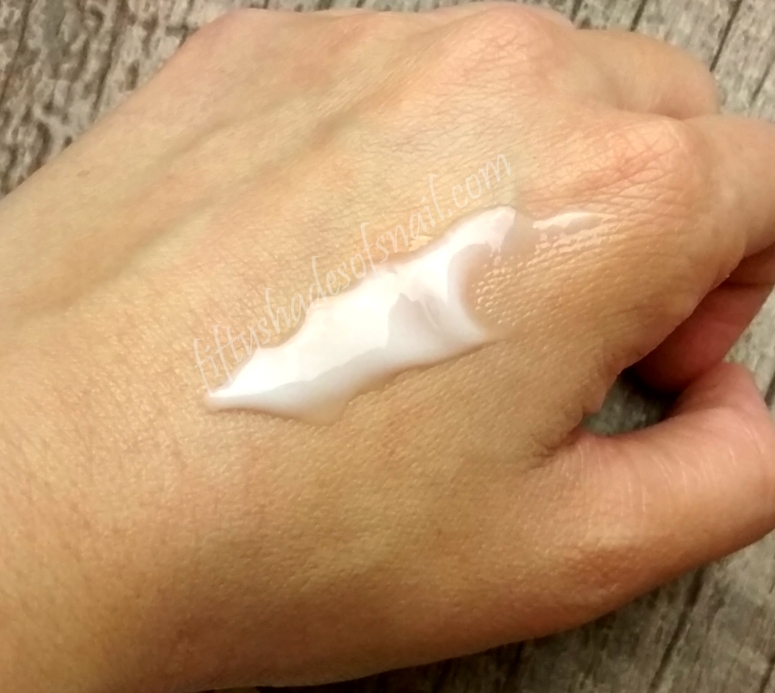
I had never heard of PHA (total skin noob) until this week when I got two samples of Cosrx’s PHA Moisture Renewal from Jolse, and now your post has popped up! Funny how things work like that.
LikeLike
Right? It isn’t new either, as PHA research has been around for over a decade!
LikeLike
Hello Fiddy , do you use your tretinoid treatment the same night you use PHA ?
LikeLike
Yup! I do tretinoin every night.
LikeLike
Right now I am adjusting to a Tretinoin 0.5% treatment and got some minor dryness and redness only around the chin area.So I was wondering, should I keep on using my Glycolic peel 10% treatment ( by an European brand I’m not expecting you to be familiar with) once-twice per week as I used to, or should I wait to adjust to Tretinoin first, or I should stop with the peeling overall? Any insight,please? And also, I am willing to try a Korean beauty peeling,but since Swanicocco don’t do samples of their PHA peeling or at least that’s what a quick rummage through ebay and google revealed, and I’ll be damned if I was to spend that much money for a full size product I haven’t sampled first….eeermm,would you Snail Lady be that kind to recommend a decent peeling,but one that I could eventually,trial first? Best regards from Brits doldrums and all that 😀
LikeLike
Hi! While I would defer to your doctor’s advice on this, personally I would absolutely cut the 10% glycolic acid for now as well as any other chemical exfoliation until your skin adjusts a bit more. If you want to do some light exfoliation, I would suggest a gommage peel as that will be much more gentle but still get rid of skin flakes. I’m not sure which ones have sample sizes, but if you search for “peeling gel” on whatever shopping sites you use, some should come up, and most of them have a pretty similar action.
LikeLike
I was really happy to see this post, as I’m looking to add some ultra gentle exfoliation into my routine!
My question is, I’m currently using Tony Moly’s banana peeling cream. I apply a layer to my skin, wait a few minutes, then massage my skin until grits start to come out. That’s how most peeling products I’ve researched work. But with this product, all I’d do is apply it like a normal cream-type product, no extra massaging? You mention grits coming out of your skin, is that when you’re applying this cream or just in general after introducing this product into your routine?
Thanks Fiddy! I know my questions are silly and overly specific but I really appreciate your blog and all the information you provide!
LikeLike
Those are not silly questions at all and I totally understand the confusion, since a “peeling gel” is a specific type of product and this has “peeling” in the name. You are correct, this is not a gommage peel. You apply it like a regular cream. The grits come out for me as a result of regular use of it rather than from a single session.
I hope that helps!!
LikeLike
P.s- I tagged you on face book to a picture of a giant snail-pet someone was carrying in their embrace, don’t know if you’ve been able to see it? The bloody thing was as big as my French Papillon lap dog, I swear. Made me think of you. Don’t mind me,just saying…..
LikeLike
Oh! I haven’t been on FB in forever but I think I know which picture you’re talking about! I couldn’t decide if I was horrified or excited by the idea of a giant-ass snail pet.
LikeLike
Hello Fiddy, In YOUR routine, that includes tretinoin, where do you fit in the BHA? Do you apply it before/after your tretinoin? Just curious.
LikeLike
I do the BHA right after cleansing and usually just on my nose, T-zone at most. Then I just let it dry while I’m putting body lotion or whatever, and move on to the next step.
LikeLiked by 1 person
Thanks for the response! 🙂
LikeLiked by 1 person
I assume PHA is like AHA which means its strength is pH dependent, I didn’t see you discuss that, curious to know what you think about that 🙂 Thank you for the post!
LikeLike
I discuss it a bit in the Notable Ingredients section, where I provide the pH of this product as well ☺️
LikeLike
How did I miss that lol! Sorry 🙂
LikeLike
Fingerless gloves are pretty awesome if you have a workplace (or wherever, for me workplace) that tends to be chilly. They keep your wrists and part of your hands warm, leaving your fingers free to type or do whatever. I don’t use them for warmth outside, necessarily, but I do usually have a pair in whatever bag I am bringing to work.
LikeLiked by 1 person
Dear Fiddy,
Allow me to be awkward and tell you that I am #obsessed with your blog. It even warrants a hashtag. 😉 Can I tap into your wisdom (okay, please just give me your opinion) on a Snail Thing? I gave the CosRX 96 Snail Mucin a few tries at different points within the last few months. Hot weather, cold weather, both before and after I fixed my moisture barrier. Every time I used it my skin felt moist (albeit sticky) right after application, but within an hour would start drying out. By mid day I felt all the moisture had been sapped from my skin.
I desperately want some snail juice goodness in my life and I’m confused why this one isn’t doing it for me. Of course YMMV, but do you have any theories as to why it would make my skin DRIER? I’ve tried a couple other snail products (Benton’s ampoule and Swanicoco’s ferment emulsion) and they were fine – nothing magical – and offered moisture.
xoxo
LikeLike
Hiiiii and thank you so much for the kind words! I’m not super sure why that would be happening off the top of my head. Have you compared the ingredients side by side to see which ones are only in the Cosrx? I think it should be fairly easy to spot considering how short their snail ingredient list is. I would love to hear what you find!
LikeLike
How does it compare to Naruko’s 20% Mandelic Acid?
LikeLike
Oh hey wow this sounds interesting. I was expecting a typical physical peeling cream that balls up and rubs off. I have heard of PHAs…I tried a Naruko product (Jobs Tears Essence) that had gluconolactone in it and I noticed my skin gradually got smoother and glowier. Hm…I will have to try this sometime!
LikeLike